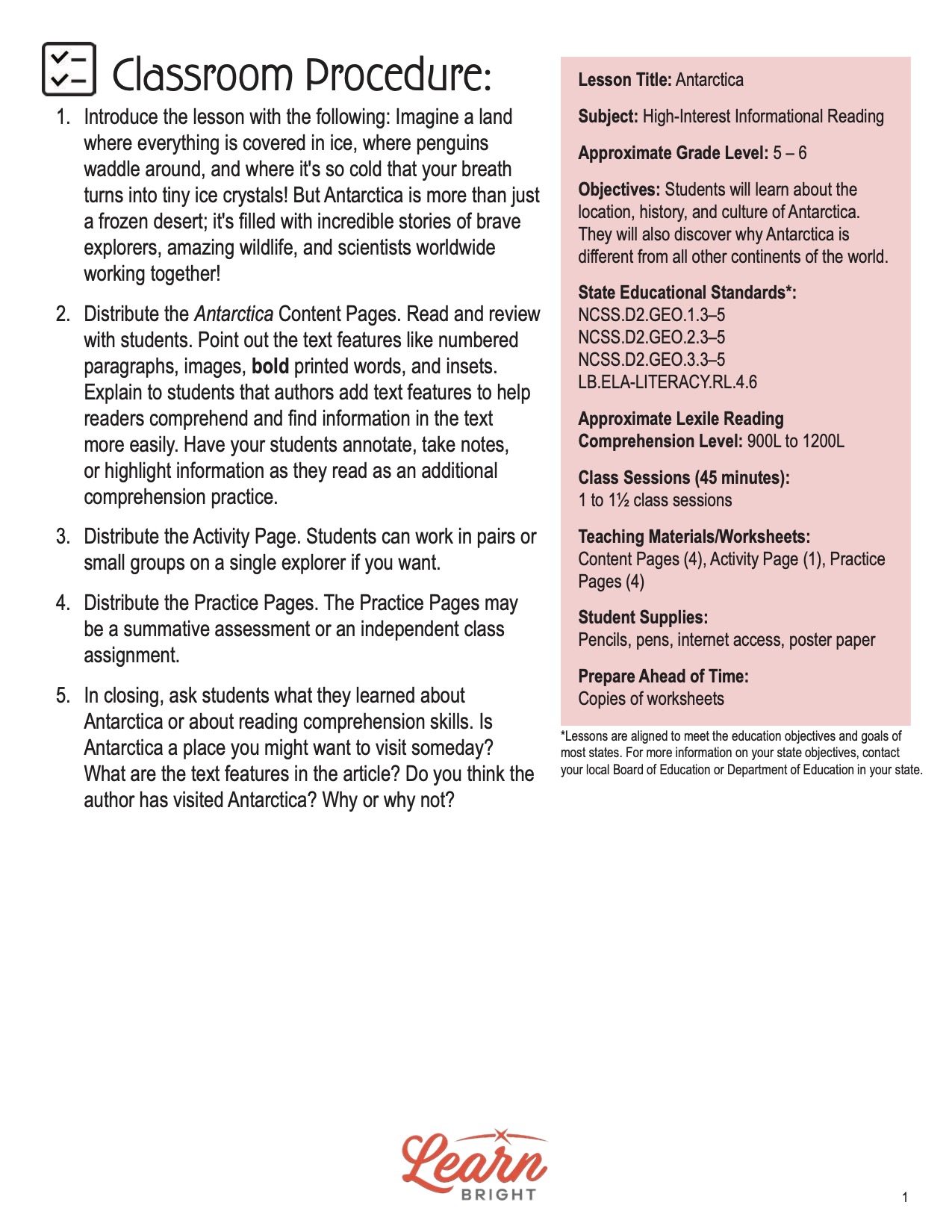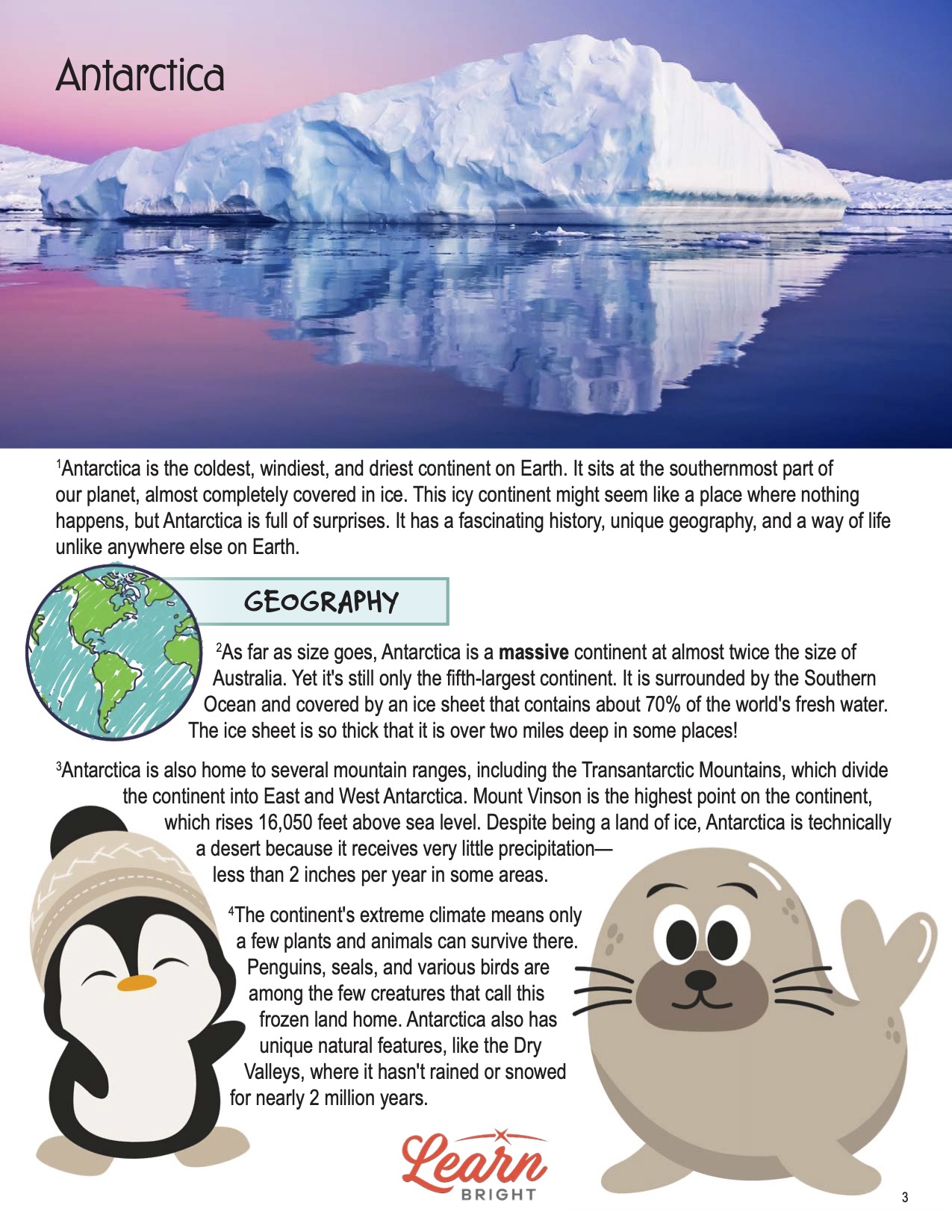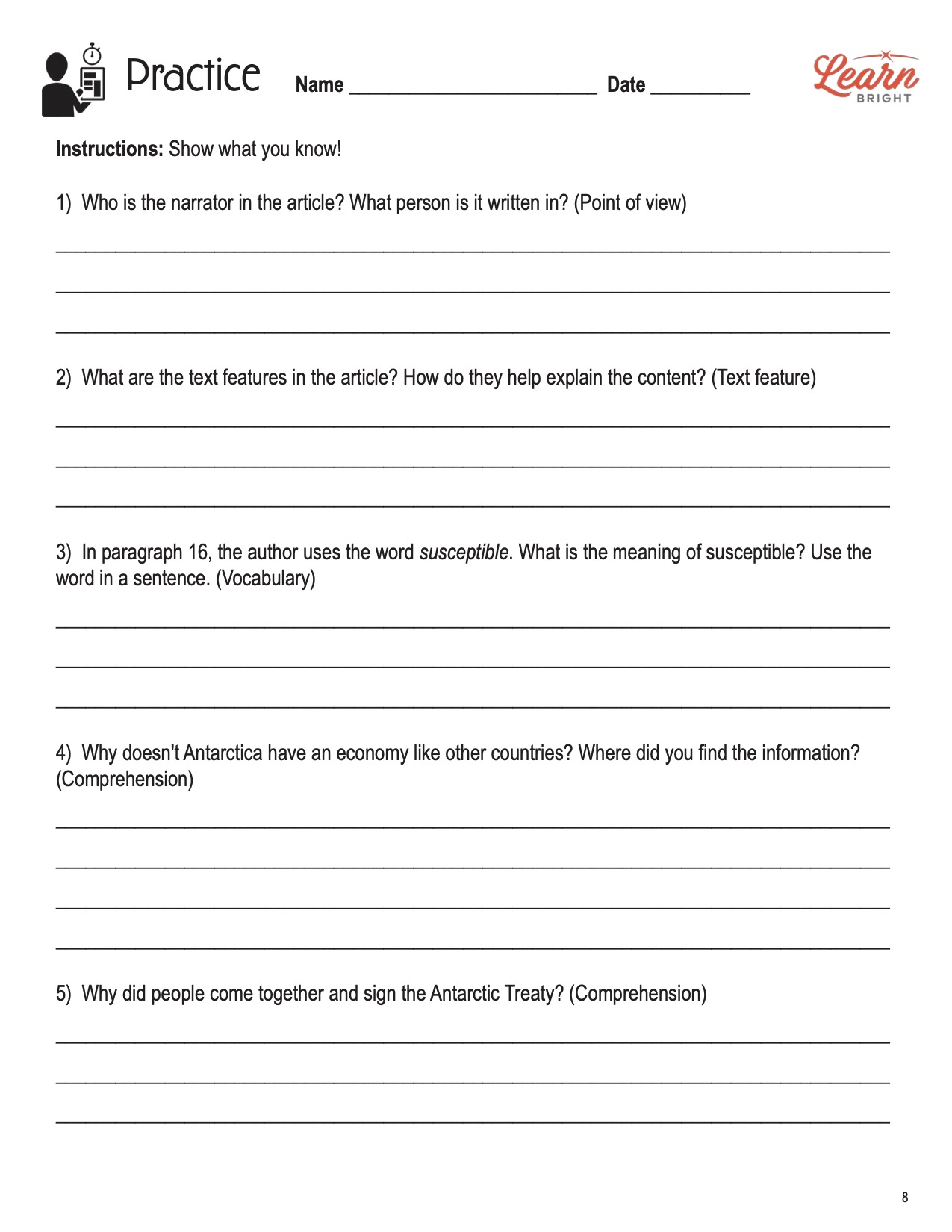Description
What our Antarctica lesson plan includes
Lesson Objectives and Overview: Antarctica is a high-interest reading comprehension lesson plan. As such, students will practice various close reading and comprehension skills. They will also discover why Antarctica is different from all other continents of the world. This lesson is for students in 5th grade and 6th grade.
Classroom Procedure
Every lesson plan provides you with a classroom procedure page that outlines a step-by-step guide to follow. You do not have to follow the guide exactly. The guide helps you organize the lesson and details when to hand out worksheets. It also lists information in the yellow box that you might find useful. You will find the lesson objectives, state standards, and number of class sessions the lesson should take to complete in this area. In addition, it describes the supplies you will need as well as what and how you need to prepare beforehand. The only thing you’ll need in addition to pens, pencils, or highlighters is poster paper for the activity.
Teacher Notes
The paragraph on this page gives you a little more information on the lesson overall and describes what you may want to focus your teaching on. It explains that you can teach this lesson in a whole-class setting or as an independent, small-group activity. The blank lines are available for you to write out any thoughts or ideas you have as you prepare.
ANTARCTICA LESSON PLAN CONTENT PAGES
The Antarctica lesson plan contains four content pages. Antarctica is the coldest, windiest, and driest continent on Earth. It sits at the southernmost part of our planet, almost completely covered in ice. This icy continent might seem like a place where nothing happens, but Antarctica is full of surprises. It has a fascinating history, unique geography, and a way of life unlike anywhere else on Earth.
Geography
As far as size goes, Antarctica is a massive continent at almost twice the size of Australia. Yet it’s still only the fifth-largest continent. It is surrounded by the Southern Ocean and covered by an ice sheet that contains about 70% of the world’s fresh water. The ice sheet is so thick that it is over two miles deep in some places!
Antarctica is also home to several mountain ranges, including the Transantarctic Mountains, which divide the continent into East and West Antarctica. Mount Vinson is the highest point on the continent, which rises 16,050 feet above sea level. Despite being a land of ice, Antarctica is technically a desert because it receives very little precipitation—less than 2 inches per year in some areas.
The continent’s extreme climate means only a few plants and animals can survive there. Penguins, seals, and various birds are among the few creatures that call this frozen land home. Antarctica also has unique natural features, like the Dry Valleys, where it hasn’t rained or snowed for nearly 2 million years.
History of Antarctica
For a long time, Antarctica was just a myth, a place that people imagined existed but hadn’t actually seen. It wasn’t until the early 19th century that explorers finally set foot on the frozen land. In 1820, a Russian expedition led by Fabian Gottlieb von Bellingshausen and Mikhail Lazarev became the first to sight the Antarctic mainland.
However, the early 20th century rolled around before people really started exploring Antarctica. One of the most famous explorers was Ernest Shackleton, who led several expeditions to the continent. His most renowned journey was the Imperial Trans-Antarctic Expedition in 1914–1916. During the journey, his ship called HMS Endurance got trapped in the ice. The crew had to survive on the frozen land for months.
The history of Antarctica is also marked by the race to the South Pole. In 1911, a Norwegian explorer named Roald Amundsen became the first person to reach the pole, beating a British team led by Robert Falcon Scott by just a few weeks.
Government and Treaties
Antarctica is unique because no single country owns it. Instead, it is governed by an international agreement called the Antarctic Treaty, which was signed in 1959 by 12 countries, including the United States, the Soviet Union, and the United Kingdom. Today, more than 50 countries have signed the treaty.
The Antarctic Treaty established Antarctica as a place for peace and science. It forbids military activities, mining, and nuclear explosions on the continent. The treaty also promotes scientific research and cooperation among countries. This means that instead of competing, scientists worldwide work together to study Antarctica and its environment.
There are no cities or permanent residents in Antarctica, only research stations where scientists live and work for part of the year. The largest of these is the McMurdo Station, operated by the United States, which can house over 1,000 people during the summer months.
Economy
Naturally, Antarctica doesn’t have an economy as other continents do because there are no permanent residents or industries. However, the continent does play an essential role in global science and environmental research, which can have economic impacts. Scientific research in Antarctica focuses on many areas, including climate change, wildlife, and geology. The continent is a natural laboratory where scientists can study the effects of global warming and other environmental issues. The data scientists collect help them understand our planet better and make decisions that can affect economies worldwide.
Tourism is another way Antarctica contributes to the global economy. Although the number of tourists is limited to protect the environment, thousands visit Antarctica annually. They see the stunning landscapes and wildlife and can set foot on the southernmost continent. These tours are expensive, but the money tourists spend supports businesses in nearby countries like Argentina and Chile.
Antarctica Culture
Antarctica doesn’t have a native culture or indigenous people because no one has ever lived there permanently. However, the scientists and support staff who work in Antarctica have created a unique culture of their own.
Life on the icy continent is challenging, with extreme cold, long periods of darkness during the winter, and isolation from the rest of the world. People in Antarctica rely on teamwork and community to cope with these conditions. They often live in close quarters and must work together to survive the harsh environment. Social activities, like movie nights, games, and holiday celebrations, are important for keeping morale high.
The international nature of Antarctica also means that people from many different cultures come together on the continent. It’s common to find people from countries all over the world working side by side in the research stations. This creates a unique environment where cultural exchange is a part of daily life.
Modern Antarctica
Today, Antarctica is more important than ever for scientific research. The continent plays an important role in understanding climate change because the ice sheets and glaciers are susceptible to temperature changes. Scientists study the ice cores—samples of ice drilled from the ice sheet—to learn about past climates and predict future changes.
Modern technology has also made it easier to explore and study Antarctica. Satellites provide detailed images of the continent, allowing scientists to monitor changes in the ice and weather patterns. Drones map areas that are difficult to reach, and advanced equipment will enable researchers to live and work in Antarctica year round. Despite its remote location, Antarctica is connected to the rest of the world through communication satellites and the internet. This allows scientists to share their findings with people around the globe in real time.
As we continue to learn more about this frozen land, it’s clear that Antarctica is not just a barren wasteland but a vital part of our world. Its ice holds the history of our planet, and its future will impact us all.
ANTARCTICA LESSON PLAN WORKSHEETS
The Antarctica lesson plan includes two worksheets: an activity worksheet and a practice worksheet. Each one will help students solidify their grasp of the material they learned throughout the lesson. You can refer to the classroom procedure guidelines to know when to hand out each worksheet.
EXPLORE ANTARCTICA ACTIVITY WORKSHEET
For the activity, students will choose an explorer who has visited Antarctica sometime in history. They will answer a list of questions using the research they found. Then they will draw a picture that relates to their explorer on the poster board.
REVIEW PRACTICE WORKSHEET
The practice worksheet requires students to answer a series of 10 questions. These questions all relate to the content pages, so students will need to refer to them often for the answers. In addition, each question provides which reading tool the question corresponds to, such as text feature, vocabulary, or comprehension.
Worksheet Answer Keys
At the end of the lesson plan document is an answer key for the practice worksheet. The correct answers are all in red to make it easier for you to compare them with students’ responses. If you choose to administer the lesson pages to your students via PDF, you will need to save a new file that omits these pages. Otherwise, you can simply print out the applicable pages and keep these as reference for yourself when grading assignments.









